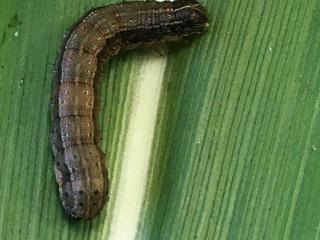Western Australia
April 30, 2020

Fall armyworm larva on maize.
Fall armyworm has been found in the Gascoyne region, with moths detected in Department of Primary Industries and Regional Development (DPIRD) traps in Carnarvon.
The pest specimens were collected in pheromone traps located near a sweet corn crop.
DPIRD senior research scientist Helen Spafford encouraged growers in the Gascoyne region to actively monitor all horticultural crops, especially sweet corn, tomato and melons.
“Producers should be vigilant in checking for larvae in their crops, monitor unusual levels of damage, and report suspected fall armyworm to the department to assist with surveillance and potential management options,” Dr Spafford said.
The pest has been found in the Kimberley, Northern Territory and Queensland.
DPIRD officers are liaising with growers and agronomists in WA to provide support with trapping and advice on minimising the impact of fall armyworm in horticultural and grains crops.
“Fall armyworm is living up to its reputation for dispersal and spread,” Dr Spafford said.
“The department is working to expand trapping into grain growing areas during the growing season.
“We are collaborating with our colleagues in the Northern Territory and Queensland to investigate management options.”
Dr Spafford encouraged growers to approach the management of this pest in a similar way to other armyworm and lepidoptera pests in crops.
“While the use of insecticides is the primary means of managing this pest at this time, careful and judicious use is advised,” she said.
“This insect develops resistance rapidly and there are natural enemies that will reduce the numbers of fall armyworm. We need to protect the natural enemies and beneficial insects such as pollinators.”
Permits are in place for fall armyworm control in horticulture and grains crops. More information is available from the Australian Pesticides and Veterinary Medicines Authority (APVMA) website.
Producers, agronomists and homeowners are asked to report suspected armyworm damage to DPIRD’s Pest and Disease Information Service on +61 (0)8 9368 3080, email padis@dpird.wa.gov.au, or use the MyPestGuide Reporter app.
More information, including presentations from a webinar conference held with more than 70 growers, agronomists and stakeholders in Kununurra, is available here.